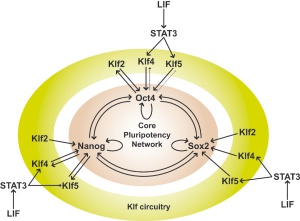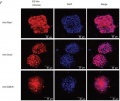Stem Cells - Induced
Introduction
The term "induced stem cell" refers to the new methods of gene introduction and expression that generate stem cells from both embryo and adult tissues.
A useful guide (online PDF document) to stem cells was produced in a report by the National Institute of Health (NIH, USA, May 2000) Stem Cells: A Primer (note large size - 4.84 Mb) and more recently NIH has established a Stem Cell information page.
Some Recent Findings
|
The Nobel Prize in Physiology or Medicine 2012 was awarded jointly to Sir John B. Gurdon and Shinya Yamanaka "for the discovery that mature cells can be reprogrammed to become pluripotent"
|
Induced Pluripotent Stem Cell

(iPS cell) A reprogrammed adult stem cell to form an embryonic stem cell, from which tissues or whole animals can develop. Can be generated by the expression of just four specific transcription factors.
Links: Nature Jul09 | ABC - Mice pups bred from adult stem cells
Yamanaka Factors
Yamanaka Factors[3][4] Are a set of 4 transcription factors when introduced into cells induces stem cell formation. These four transcription factors can be expressed from doxycycline (dox)-inducible lentiviral vectors.
OCT4
- Transcription factors containing the POU homeodomain
- Links: OMIM - OCT4
SOX2
- Sry-related HMG-Box gene 2
- Links: OMIM - SOX2
KLF4
- Kruppel-like factor 4, zinc finger protein, transcription factor which acts as both an activator and repressor.
- Links: OMIM - KLF4
cMyc
- The MYC protooncogene encodes a DNA-binding factor that can activate and repress transcription.
- Ectopic expression of c-Myc can also cause tumorigenicity in offspring.
- Links: OMIM - MYC The MYC protooncogene encodes a DNA-binding factor that can activate and repress transcription. Ectopic expression of c-Myc can also cause tumorigenicity in offspring.
- More recently shown that Oct4 together with either Klf4 or c-Myc is sufficient to generate iPS cells from neural stem cells.[5]
- Tbx3 transcription factor significantly improves the quality of iPS cells.[6]
Generation of human melanocytes from induced pluripotent stem cells
PLoS One. 2011 Jan 13;6(1):e16182.
Ohta S, Imaizumi Y, Okada Y, Akamatsu W, Kuwahara R, Ohyama M, Amagai M, Matsuzaki Y, Yamanaka S, Okano H, Kawakami Y. Source Division of Cellular Signaling, Institute for Advanced Medical Research, Keio University School of Medicine, Tokyo, Japan. Abstract Epidermal melanocytes play an important role in protecting the skin from UV rays, and their functional impairment results in pigment disorders. Additionally, melanomas are considered to arise from mutations that accumulate in melanocyte stem cells. The mechanisms underlying melanocyte differentiation and the defining characteristics of melanocyte stem cells in humans are, however, largely unknown. In the present study, we set out to generate melanocytes from human iPS cells in vitro, leading to a preliminary investigation of the mechanisms of human melanocyte differentiation. We generated iPS cell lines from human dermal fibroblasts using the Yamanaka factors (SOX2, OCT3/4, and KLF4, with or without c-MYC). These iPS cell lines were subsequently used to form embryoid bodies (EBs) and then differentiated into melanocytes via culture supplementation with Wnt3a, SCF, and ET-3. Seven weeks after inducing differentiation, pigmented cells expressing melanocyte markers such as MITF, tyrosinase, SILV, and TYRP1, were detected. Melanosomes were identified in these pigmented cells by electron microscopy, and global gene expression profiling of the pigmented cells showed a high similarity to that of human primary foreskin-derived melanocytes, suggesting the successful generation of melanocytes from iPS cells. This in vitro differentiation system should prove useful for understanding human melanocyte biology and revealing the mechanism of various pigment cell disorders, including melanoma.
PMID 21249204
Thomson Factors
OCT4
- Links: OMIM - OCT4
SOX2
- Links: OMIM - SOX2
NANOG
- Links: OMIM - NANOG
LIN28
- Links:
Target Genes
Oct4, Nanog, and Sox2 target genes
References
Reviews
<pubmed>17157222</pubmed> <pubmed>17123233</pubmed> <pubmed>17076989</pubmed>
Articles
- Journal of Visualized Experiments - Generating iPS Cells from MEFS through Forced Expression of Sox-2, Oct-4, c-Myc, and Klf4
<pubmed>19898493</pubmed> <pubmed>17282993</pubmed> <pubmed>17234930</pubmed>
Search PubMed
Search PubMed: Feb 2007 "adult stem cells" 811 reference articles of which 367 were reviews.
Search PubMed Now: adult stem cells | induced pluripotent stem cell |
Additional Images
External Links
External Links Notice - The dynamic nature of the internet may mean that some of these listed links may no longer function. If the link no longer works search the web with the link text or name. Links to any external commercial sites are provided for information purposes only and should never be considered an endorsement. UNSW Embryology is provided as an educational resource with no clinical information or commercial affiliation.
- Center for iPS Cell Research and Application, Kyoto University Generation of Human induced Pluripotent Stem Cells PDF
- Journal of Visualized Experiments - Generating iPS Cells from MEFS through Forced Expression of Sox-2, Oct-4, c-Myc, and Klf4
- NIH Stem Cells - [http://stemcells.nih.gov/staticresources/info/scireport/PDFs/Chapter_10.pdf
Glossary Links
- Glossary: A | B | C | D | E | F | G | H | I | J | K | L | M | N | O | P | Q | R | S | T | U | V | W | X | Y | Z | Numbers | Symbols | Term Link
Cite this page: Hill, M.A. (2024, April 18) Embryology Stem Cells - Induced. Retrieved from https://embryology.med.unsw.edu.au/embryology/index.php/Stem_Cells_-_Induced
- © Dr Mark Hill 2024, UNSW Embryology ISBN: 978 0 7334 2609 4 - UNSW CRICOS Provider Code No. 00098G




